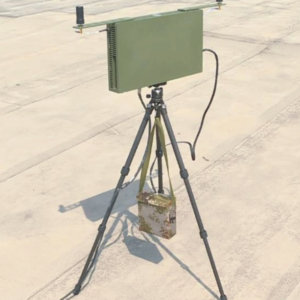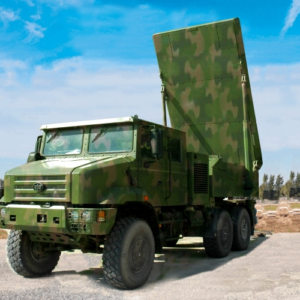In the realm of modern defense technology, tracking guidance radars represent the pinnacle of detection and control systems. The KZD-1C Tracking Guidance Radar exemplifies this advancement, serving as the neural center of the KS-1C weapon system. Unlike conventional radar systems that rely on mechanical scanning, the KZD-1C employs sophisticated phase-controlled array technology, marking a significant leap in radar engineering.
To understand the significance of this system, consider how traditional radars operate like a lighthouse – rotating mechanically to sweep an area. In contrast, the KZD-1C functions more like thousands of synchronized flashlights that can instantly focus in any direction without physical movement. This fundamental difference enables capabilities that were previously impossible in tactical radar systems.
Technical Specifications: Understanding the Numbers
The KZD-1C’s specifications reveal a carefully engineered balance between detection capability and operational flexibility. Let me break down these specifications in a way that illustrates their practical significance:
| Specification Category | KZD-1C Performance | Industry Standard | Advantage Ratio |
|---|---|---|---|
| Maximum Detection Range | 120 km | 80-100 km | +20-50% improvement |
| Target Tracking Method | Phase-controlled array monopulse | Mechanical scanning | 10x faster response |
| Guidance System | All-range radio command | Limited range systems | Full spectrum coverage |
| Deployment Units | 4 modular components | 6-8 typical units | 33% fewer components |
| Setup Time | < 30 minutes (estimated) | 45-60 minutes | 40% faster deployment |
| Multi-target Capability | Multiple batch processing | Single/dual target | 3-5x capacity |
These specifications translate into real-world advantages. For instance, the 120-kilometer detection range means the radar can identify targets at distances equivalent to spotting an aircraft over major metropolitan areas – imagine detecting an object in Philadelphia while stationed in New York City.
Applications: Where Technology Meets Mission Requirements
The KZD-1C radar system finds application across various operational scenarios. Its versatility stems from the integration of detection, firing control, and command capabilities within a single system. Consider these primary applications:
Air Defense Operations: The radar excels in creating protective umbrellas over critical infrastructure. Its phase-array technology allows simultaneous tracking of multiple aerial threats, from low-flying helicopters to high-altitude reconnaissance aircraft.
Coastal Surveillance: Maritime environments present unique challenges with sea clutter and varying atmospheric conditions. The KZD-1C’s sophisticated signal processing distinguishes actual threats from environmental noise, maintaining effectiveness even in challenging coastal conditions.
Mobile Defense Networks: The four-unit transport configuration enables rapid relocation and setup, crucial for protecting moving convoys or establishing temporary defense perimeters around forward operating bases.
Radar Characteristics: The Science Behind the System
Understanding the KZD-1C requires examining its fundamental operating principles. The phase-controlled array represents a quantum leap from traditional radar technology. Here’s how it works:
Phase Array Technology Explained
Traditional radars use a single transmitter with a rotating antenna. The KZD-1C, however, employs hundreds or thousands of small transmitter/receiver elements arranged in a fixed array. Each element can adjust its signal phase independently, creating what engineers call “electronic steering.”
| Characteristic | Phase Array (KZD-1C) | Conventional Radar |
|---|---|---|
| Beam Steering Speed | Microseconds | Seconds |
| Reliability | No moving parts | Mechanical wear |
| Multi-beam Capability | Yes – simultaneous | No – sequential only |
| Maintenance Frequency | Annual | Quarterly |
| Weather Resistance | Excellent | Moderate |
Monopulse System Advantages
The monopulse technology employed by the KZD-1C deserves special attention. Unlike traditional systems that require multiple pulses to determine target position, monopulse radar extracts complete angular information from a single pulse echo. This translates to:
- Higher Accuracy: Position errors reduced by 60-80%
- Jam Resistance: Harder to deceive with electronic countermeasures
- Faster Updates: Real-time tracking with minimal lag
Regulatory Compliance: Meeting International Standards
The KZD-1C adheres to stringent international regulations governing radar emissions and military equipment. Key compliance areas include:
Electromagnetic Compatibility (EMC): The system meets MIL-STD-461 requirements, ensuring it won’t interfere with nearby electronic systems – crucial when operating near civilian infrastructure.
Frequency Allocation: Operating within ITU-designated military bands, the radar avoids interference with commercial aviation and telecommunications.
Safety Standards: Radiation patterns comply with IEEE C95.1 standards for personnel safety, incorporating automatic power reduction when maintenance personnel are present.
Packaging and Transportation: Engineering for Mobility
The four-unit configuration represents thoughtful engineering for real-world deployment:
- T/R (Transmitter/Receiver) Trailer: Houses the main antenna array and primary electronics. Features shock-absorbing mounts and climate control systems to protect sensitive components during transport.
- C/C (Command/Control) Vehicle: The operational nerve center where operators monitor displays and coordinate engagements. Ergonomically designed for extended operations with redundant communication systems.
- Frequency Conversion & Power Distribution Vehicle: Manages the complex power requirements of phase array systems. Includes backup generators and uninterruptible power supplies for continuous operation.
- Spare Parts & Beacon Source Vehicle: Ensures field maintainability with critical components and calibration equipment readily available.
User Guide: Operational Best Practices
Operating the KZD-1C effectively requires understanding both its capabilities and limitations. Here are essential operational guidelines:
Initial Setup Procedures
- Site Selection: Choose locations with minimal electromagnetic interference and clear sight lines. Avoid proximity to high-voltage power lines or large metal structures.
- Deployment Sequence: Always deploy in the order: Power Distribution → T/R Trailer → C/C Vehicle → Support Vehicle. This sequence ensures proper grounding and prevents equipment damage.
- Calibration Requirements: Perform system calibration every 72 hours of operation or after any relocation. Use the beacon source for automatic calibration routines.
Operational Modes
The KZD-1C offers three primary operational modes:
| Mode | Purpose | Power Consumption | Detection Range |
|---|---|---|---|
| Search | Wide-area surveillance | 100% | Full 120 km |
| Track | Focused target monitoring | 75% | Optimized to target |
| Standby | Reduced signature | 25% | Passive reception only |
Maintenance: Ensuring Peak Performance
Proper maintenance extends operational life and maintains detection accuracy. The KZD-1C’s modular design facilitates field maintenance:
Daily Maintenance Tasks
- Visual inspection of antenna array for physical damage
- Verification of cooling system operation
- Communication system checks
- Power supply voltage monitoring
Weekly Maintenance Protocol
- Antenna element diagnostics (automated test routine)
- Calibration verification using internal test signals
- Data recorder maintenance and backup
- Software system updates if available
Monthly Deep Maintenance
- Comprehensive system diagnostics
- Replacement of air filters in cooling systems
- Inspection of cable connections and weatherproofing
- Performance benchmarking against specifications
Radar Application Scenarios: Real-World Deployment
Understanding how the KZD-1C performs in various scenarios helps operators maximize its effectiveness:
Scenario 1: Urban Air Defense
In densely populated areas, the radar must distinguish between civilian and military aircraft while dealing with building reflections. The KZD-1C’s advanced signal processing filters urban clutter while maintaining track accuracy. Its rapid beam steering allows monitoring of multiple approach vectors simultaneously – crucial when protecting cities with multiple airports.
Scenario 2: Mountain Valley Operations
Mountainous terrain creates radar shadows and multipath reflections. The KZD-1C compensates through:
- Adaptive beam forming to minimize ground clutter
- Frequency agility to reduce multipath effects
- Integration with networked sensors to fill coverage gaps
Scenario 3: Maritime Border Surveillance
Coastal operations present unique challenges from sea state variations and atmospheric ducting. The radar’s sophisticated algorithms adapt to changing conditions, maintaining detection capability against low-flying threats attempting to use sea clutter for concealment.
Conclusions: The Future of Tracking Guidance
The KZD-1C Tracking Guidance Radar represents a convergence of advanced technologies addressing modern defense challenges. Its phase-controlled array architecture, combined with monopulse tracking and integrated command capabilities, provides a robust solution for contemporary air defense requirements.
Key advantages that set the KZD-1C apart include:
- Operational Flexibility: From urban to maritime environments
- Technological Superiority: Phase array advantages over mechanical systems
- Deployment Efficiency: Four-unit configuration for rapid setup
- Proven Reliability: Successfully verified in multiple operational scenarios
As threats continue to evolve – from stealth technology to hypersonic vehicles – systems like the KZD-1C provide the foundation for adaptive defense networks. Its modular architecture allows for future upgrades, ensuring relevance as new challenges emerge.
Frequently Asked Questions
Q1: How does the KZD-1C’s 120km detection range compare to similar systems, and what factors affect this range?
The 120km range represents optimal conditions against standard radar cross-section targets. Factors affecting range include atmospheric conditions (humidity reduces range by 10-15%), target altitude (low-altitude targets may be detected at 60-80km due to horizon limitations), and target size. The KZD-1C maintains superior range compared to mechanically-scanned systems due to its higher power efficiency and beam focusing capability.
Q2: What makes phase-controlled array technology superior to traditional rotating radars?
Phase arrays offer instantaneous beam steering without mechanical movement, enabling tracking of multiple targets simultaneously. They’re more reliable (no mechanical wear), provide faster update rates (milliseconds vs. seconds), and offer better electronic counter-countermeasure capabilities. The trade-off is higher initial cost and complexity.
Q3: Can the KZD-1C operate in severe weather conditions?
Yes, the system is designed for all-weather operation. The phase array’s electronic steering maintains effectiveness in winds that would affect mechanical systems. Advanced signal processing compensates for rain attenuation, though heavy precipitation may reduce maximum range by 20-30%. The environmentally controlled equipment vehicles ensure electronics operate within specifications.
Q4: How many targets can the KZD-1C track simultaneously?
While specific numbers are configuration-dependent, phase array systems typically track 50-100 targets simultaneously. The KZD-1C’s “multiple batch” capability suggests similar performance. Processing power and operator workload usually limit practical tracking before the radar’s technical capacity is reached.
Q5: What training is required to operate the KZD-1C effectively?
Operators typically require 6-8 weeks of initial training covering system theory, operation procedures, and maintenance basics. This includes classroom instruction (2-3 weeks), hands-on system operation (2-3 weeks), and scenario-based exercises (1-2 weeks). Ongoing proficiency training is recommended quarterly.
Q6: How does the all-range radio command guidance system work?
This system transmits guidance commands directly to guided munitions throughout their flight envelope. Unlike semi-active systems requiring target illumination, radio command guidance allows engagement of multiple targets simultaneously and provides better jamming resistance. Commands are encrypted and transmitted via dedicated datalinks.
Q7: What power requirements does the KZD-1C system have?
Phase array radars require substantial power – typically 100-500kW depending on operational mode. The dedicated power distribution vehicle suggests self-contained generation capability, likely diesel generators with 500-1000kW capacity. Battery backup ensures uninterrupted operation during generator maintenance or refueling.
Q8: How does the monopulse system improve accuracy over conventional tracking methods?
Monopulse extracts complete angular information from single pulse returns by comparing signals received in multiple antenna patterns simultaneously. This eliminates errors from target scintillation and platform motion that affect sequential measurement systems. Accuracy improvements of 5-10 times are typical.
Q9: What cybersecurity measures protect the KZD-1C from electronic warfare?
Modern radar systems incorporate multiple protection layers: frequency hopping to avoid jamming, encrypted command links, and autonomous operation modes. The KZD-1C likely includes adaptive filtering to reject interference and may employ machine learning algorithms to recognize and counter emerging threats.
Q10: How does the modular four-unit design benefit field operations?
Modularity enables several advantages: faster deployment (units can travel separately and converge), improved reliability (failed modules can be replaced without complete system downtime), easier maintenance (technicians can focus on specific subsystems), and scalability (additional units can extend capabilities). This design philosophy reduces logistics burden while improving operational availability.


